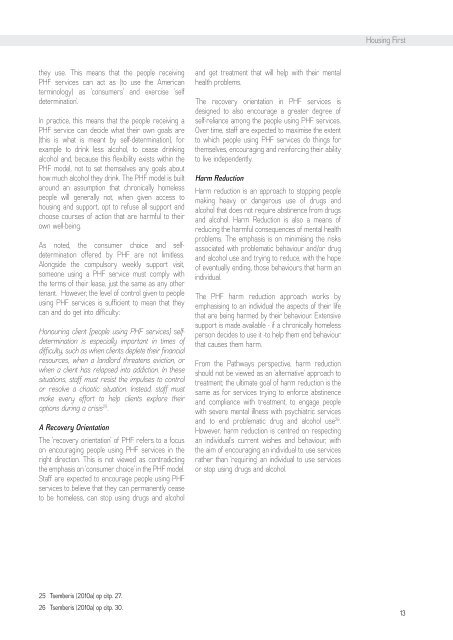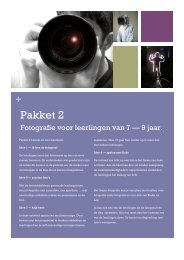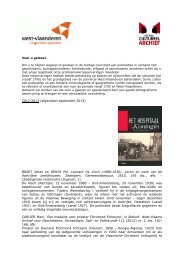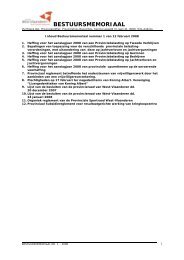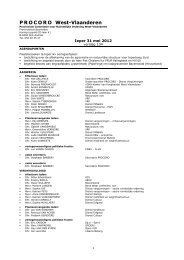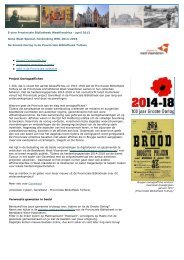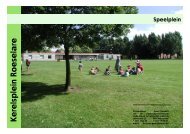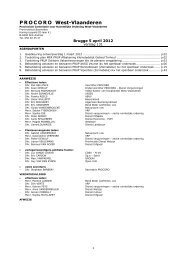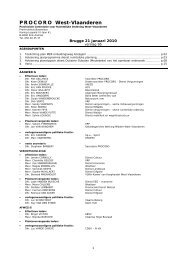Housing First - Provincie West-Vlaanderen
Housing First - Provincie West-Vlaanderen
Housing First - Provincie West-Vlaanderen
Create successful ePaper yourself
Turn your PDF publications into a flip-book with our unique Google optimized e-Paper software.
<strong>Housing</strong> <strong>First</strong>they use. This means that the people receivingPHF services can act as (to use the Americanterminology) as ‘consumers’ and exercise ‘selfdetermination’.In practice, this means that the people receiving aPHF service can decide what their own goals are(this is what is meant by self-determination), forexample to drink less alcohol, to cease drinkingalcohol and, because this flexibility exists within thePHF model, not to set themselves any goals abouthow much alcohol they drink. The PHF model is builtaround an assumption that chronically homelesspeople will generally not, when given access tohousing and support, opt to refuse all support andchoose courses of action that are harmful to theirown well-being.As noted, the consumer choice and selfdeterminationoffered by PHF are not limitless.Alongside the compulsory weekly support visit,someone using a PHF service must comply withthe terms of their lease, just the same as any othertenant. However, the level of control given to peopleusing PHF services is sufficient to mean that theycan and do get into difficulty:Honouring client [people using PHF services] selfdeterminationis especially important in times ofdifficulty, such as when clients deplete their financialresources, when a landlord threatens eviction, orwhen a client has relapsed into addiction. In thesesituations, staff must resist the impulses to controlor resolve a chaotic situation. Instead, staff mustmake every effort to help clients explore theiroptions during a crisis 25 .A Recovery OrientationThe ‘recovery orientation’ of PHF refers to a focuson encouraging people using PHF services in theright direction. This is not viewed as contradictingthe emphasis on ‘consumer choice’ in the PHF model.Staff are expected to encourage people using PHFservices to believe that they can permanently ceaseto be homeless, can stop using drugs and alcoholand get treatment that will help with their mentalhealth problems.The recovery orientation in PHF services isdesigned to also encourage a greater degree ofself-reliance among the people using PHF services.Over time, staff are expected to maximise the extentto which people using PHF services do things forthemselves, encouraging and reinforcing their abilityto live independently.Harm ReductionHarm reduction is an approach to stopping peoplemaking heavy or dangerous use of drugs andalcohol that does not require abstinence from drugsand alcohol. Harm Reduction is also a means ofreducing the harmful consequences of mental healthproblems. The emphasis is on minimising the risksassociated with problematic behaviour and/or drugand alcohol use and trying to reduce, with the hopeof eventually ending, those behaviours that harm anindividual.The PHF harm reduction approach works byemphasising to an individual the aspects of their lifethat are being harmed by their behaviour. Extensivesupport is made available - if a chronically homelessperson decides to use it -to help them end behaviourthat causes them harm.From the Pathways perspective, harm reductionshould not be viewed as an ‘alternative’ approach totreatment; the ultimate goal of harm reduction is thesame as for services trying to enforce abstinenceand compliance with treatment, to engage peoplewith severe mental illness with psychiatric servicesand to end problematic drug and alcohol use 26 .However, harm reduction is centred on respectingan individual’s current wishes and behaviour, withthe aim of encouraging an individual to use servicesrather than ‘requiring’ an individual to use servicesor stop using drugs and alcohol.25 Tsemberis (2010a) op citp. 27.26 Tsemberis (2010a) op citp. 30.13


